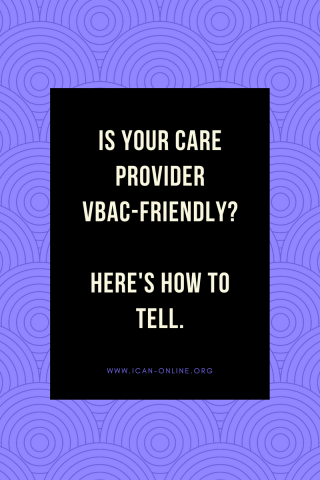 With the rate of cesarean births in the United States holding at a little over one in three, many women face an important decision when having subsequent children: plan a vaginal birth after cesarean (VBAC) or schedule a repeat C-section? Since 2010, the guidelines issued by the American Congress of Ob/Gyns (ACOG) assert that a VBAC is “a safe and appropriate choice for most women who have had a prior cesarean birth, including for some women who have had two previous cesareans.”* So not surprisingly, more and more women are choosing VBAC.
With the rate of cesarean births in the United States holding at a little over one in three, many women face an important decision when having subsequent children: plan a vaginal birth after cesarean (VBAC) or schedule a repeat C-section? Since 2010, the guidelines issued by the American Congress of Ob/Gyns (ACOG) assert that a VBAC is “a safe and appropriate choice for most women who have had a prior cesarean birth, including for some women who have had two previous cesareans.”* So not surprisingly, more and more women are choosing VBAC.
Even with these guidelines in place, many mothers unfortunately still find themselves in an uphill battle to find a care provider who truly supports VBAC. A care provider who says that he or she supports VBAC birth but puts strict limits on the labor and birth process may be “VBAC tolerant” but not exactly “VBAC friendly.” So how can a mother know if her care provider is truly VBAC-friendly? Here are three important questions to ask:
What is that care provider’s track record?
One of the most telling factors in determining whether your care provider is truly VBAC friendly, rather than someone who just pays lip service to the idea without any real plans of follow through, is to look at VBAC success rates for both the provider as well as the location(s) where he or she attends births. How many successful VBACs has the provider attended? How does that rate compare to his or her repeat cesarean rate? These are important questions to know and important questions for your care provider to address. It should be a major red flag if a care provider bristles at these questions or dismisses such questions as irrelevant.
What “requirements” does he or she have for a VBAC candidate?
There are several factors that are encouraging to both mothers and providers because they increase the chance of VBAC success. These are:
- Spontaneous onset of labor, but not necessarily by 40 weeks
- Carefully considered use of intervention to speed or strengthen labor
- The reason for a prior cesarean is unlikely to be repeated (such as a baby in the breech position)
- A supportive and patient care provider
- Giving birth in a setting that routinely supports VBACs
- Having had previous vaginal deliveries, either before or after cesarean birth
However, a VBAC, as in any birth, should be treated as its own experience with its own unique characteristics. VBAC success can be achieved without needing to pass a “checklist” of requirements. Even in this list, there are considerable gray areas. For example, while spontaneous onset of labor contributes to VBAC success, a provider who “requires” that a mother go into labor before 40 weeks is not truly VBAC-friendly. Another example would be under the criteria of how likely a reason for the prior cesarean is to be repeated, such as a mother whose prior cesarean was for suspected cephalopelvic disproportion, or CPD (when the mother’s pelvis is too small to allow for the baby to pass through). A provider who determines early in pregnancy that such a scenario is likely to be repeated is also raising a red flag. Actual cases of CPD are exceedingly rare, yet CPD is often cited as the cause for a cesarean, deemed “failure to progress.”**
What about the other care providers in the practice?
If a care provider shares the responsibility of attending births with others in his or her practice – and there is a chance that one of the other providers may attend your birth – it’s important to consider their track records and stances, as well. It doesn’t do much good if your provider truly supports VBAC but the others, who are just as likely to attend your birth, do not.
Nothing in life is without risk. Surgical birth and VBAC both involve certain risks, and a VBAC-friendly care provider will counsel a mother on the potential benefits and risks of both options. These risks will vary greatly between individuals. So when considering a VBAC, it’s important to find a provider who will look at each mother as an individual and work with her to determine what will be best for both the mother and her baby. The chances of a successful VBAC birth increase greatly with a care provider who is truly supportive.
*“Ob/Gyns Issue Less Restrictive VBAC Guidelines.” ACOG
**“Cephalopelvic Disproportion.” American Pregnancy Association
Reblogged with permission from www.PlumtreeBaby.com. By Jennifer Stutzman, Freelance Writer.